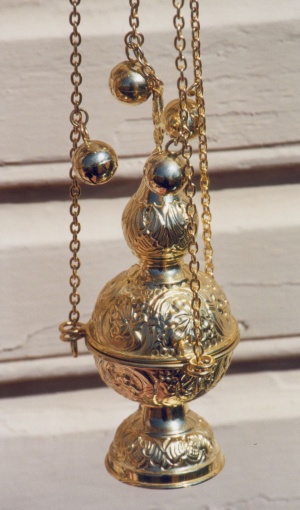Cădelniță
| Acest articol (sau părți din el) este propus spre traducere din limba engleză!
Dacă doriți să vă asumați acestă traducere (parțial sau integral), anunțați acest lucru pe pagina de discuții a articolului. |
A censer is a small metal or stone dish used for burning incense. A common design is a metal container, about the size and shape of a small coffee-pot, suspended on chains and often with the addition of small bells. The bowl contains hot coals, and the incense is placed on top of these.
Censers used in the church, known as a thurible in the Western Rite, are used during offices or services, such as Vespers, Orthros, and the Divine Liturgy. Censing is the practice of swinging a censer suspended from chains towards something or someone, typically an icon or person, so that smoke from the burning incense travels in that direction. If a deacon is present, he typically does much of the censing, otherwise the duty is undertaken by the priest. Unordained servers or acolytes are permitted to prepare and carry the censer, but may not swing it during prayers.
To the Orthodox, burning incense represents the prayers of the faithful rising towards Heaven as a sweet smelling spiritual fragrance. One commonly sung psalm during the censing is "Let my prayer rise like incense before You, the lifting up of my hands like the evening sacrifice." Some Orthodox Christians use a standing censer on their home altars.
The censer used in the liturgical services of the Church contains a bowl/recepticle which represents the Church. Some commentators suggest that this represents the Holy Theotokos because like she contained within her womb the Divine Fire, so too, the censer contains the burning coal of faith. This dish is supported by four chains each of which carries three bells. The twelve bells represent the voices of the disciples proclaiming the Gospel based on the teachings of the four Evangelists here represented by the chains.
